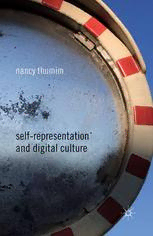
Self-Representation and Digital Culture PDF
Preview Self-Representation and Digital Culture
Self-Representation and Digital Culture Self-Representation and Digital Culture Nancy Thumim UniversityofLeeds,UK Palgrave macmillan ©NancyThumim2012 Softcoverreprintofthehardcover1stedition2012978–0–230–22966–2 Allrightsreserved.Noreproduction,copyortransmissionofthis publicationmaybemadewithoutwrittenpermission. Noportionofthispublicationmaybereproduced,copiedortransmitted savewithwrittenpermissionorinaccordancewiththeprovisionsofthe Copyright,DesignsandPatentsAct1988,orunderthetermsofanylicence permittinglimitedcopyingissuedbytheCopyrightLicensingAgency, SaffronHouse,6–10KirbyStreet,LondonEC1N8TS. Anypersonwhodoesanyunauthorizedactinrelationtothispublication maybeliabletocriminalprosecutionandcivilclaimsfordamages. Theauthorhasassertedherrighttobeidentifiedastheauthorofthis workinaccordancewiththeCopyright,DesignsandPatentsAct1988. Firstpublished2012by PALGRAVEMACMILLAN PalgraveMacmillanintheUKisanimprintofMacmillanPublishersLimited, registeredinEngland,companynumber785998,ofHoundmills,Basingstoke, HampshireRG216XS. PalgraveMacmillanintheUSisadivisionofStMartin’sPressLLC, 175FifthAvenue,NewYork,NY10010. PalgraveMacmillanistheglobalacademicimprintoftheabovecompanies andhascompaniesandrepresentativesthroughouttheworld. Palgrave®andMacmillan®areregisteredtrademarksintheUnitedStates, theUnitedKingdom,Europeandothercountries. ISBN978-1-349-31100-2 ISBN978-1-137-26513-5(eBook) DOI 10.1057/9781137265135 Thisbookisprintedonpapersuitableforrecyclingandmadefromfully managedandsustainedforestsources.Logging,pulpingandmanufacturing processesareexpectedtoconformtotheenvironmentalregulationsofthe countryoforigin. AcataloguerecordforthisbookisavailablefromtheBritishLibrary. AcatalogrecordforthisbookisavailablefromtheLibraryofCongress. 10 9 8 7 6 5 4 3 2 1 21 20 19 18 17 16 15 14 13 12 For Jesse Elvis Thumim Blake, born in the middle of it all, 2010 Contents Acknowledgements ix 1 Introduction:Self-RepresentationandDigitalCulture 1 Self-representation 1 Digitalculture 10 Theoreticalapproach 13 2 HistoriesofSelf-Representation 19 Introduction 19 Constructingordinarypeopleandcommunity 21 Constructingthepublic,buildingthenation 28 Debatingthepublic,broadeningthenation 31 Representingthepublic,limitationsofthenation 35 Publicsrepresentthemselvesinside,outsideand againstthenation 38 Politicalandeconomiccontexts:theUKcase 44 Conclusion:mediationandself-representation 46 3 Mediation 49 Introduction 49 Mediation 51 Audienceresearch 63 4 Broadcasters 70 Introduction 70 Broadcasters,self-representationanddigitalculture 71 CaptureWales:textualmediation 73 CaptureWales:culturalmediation 79 CaptureWales:institutionalmediation 87 Conclusion:self-representationandbroadcasters 101 5 MuseumsandArtWorlds 104 Introduction 104 Institutionalmediation 106 vii viii Contents Culturalmediation 125 Textualmediation 129 6 Self-RepresentationOnline 136 Introduction 136 Institutionalmediation 138 Culturalmediation 144 Textualmediation 150 Conclusion 154 7 Self-Representation,DigitalCultureandGenre 157 Introduction 157 Self-representationandgenre 158 Mediationandtheusesofthegenreof self-representation 167 Notes 182 Bibliography 187 Index 202 Acknowledgements I have benefited hugely from the insightful comments of colleagues in several institutions. At the London School of Economics, I am grateful to my PhD supervisor, Sonia Livingstone, and to Roger Silverstone, Lilie Chouliaraki, Nick Couldry, Zoe Sujon and Giota Alevizou for comments (and sometimes collaborations) at crucial stages.IamgratefultocolleaguesintheMediatizedStoriesNetwork, inparticularKnutLundby.ThisnetworkintroducedmetoGunnSara Enli,withwhomIdevelopedideasabouthowherworkonsocialising intersected with my ideas about self-representation. At Goldsmiths, Bev Skeggs and Helen Wood got me thinking about my ideas on self-representationinrelationtorealityTV. Mynewacademichome,theInstituteofCommunicationsStudies at the University of Leeds, has provided a stimulating environment for finishing the book. In particular, Stephen Coleman has been a thoughtful,criticalandsupportivereader,andtheLeedsMediaEcol- ogy project team (Stephen Coleman, Giles Moss, Jay G. Blumler, Judith Stamper and Steven McDermott) has provided stimulating debatethathashelpedtosharpenthefocusofthefinalmanuscript. The book has also benefited enormously from the thoughtful com- ments of two anonymous reviewers. I am grateful to the Economic and Social Research Council and the Research Council of Norway for funding that allowed me to pursue this research. I have also enjoyed working with Felicity Plester, my helpful editor at Palgrave Macmillan. OrdinarypeopleparticipatingintheCaptureWales,London’sVoices and Ethical Scenarios of Class and Self research projects helped to make this book. Producers, curators and other staff at the Museum of London and BBC Wales New Media Department, as well as rep- resentatives of funding bodies and partner organisations who spoke withmeandletmeobservetheiractivities,alsohelpedtomakethis book. Mandy Rose, in particular, tipped me off about an innovative new project at BBC Wales and became a good friend over time. The practical help of Vanessa Cragoe over a number of years and Divya ix x Acknowledgements Maharajh at a crucial moment most recently has been invaluable. Then,of course, I am gratefulto all the people who have been with me along the way, especially Ella Thumim, Rebecca Geldard, Molly Conisbee,HannahGriffiths,BrandThumim,LindaBarr,EleanorBarr, Joshua Thumim, Anna Jephcote, Luca and Maeve Thumim. Gary Blake, Rhiannon Blake and Jesse Elvis Thumim Blake slowed me downandshowedmetheview–andit’sabetterbookforit.Finally, JanetThumimgavemeatasteforthepoliticsofrepresentationand hasconsistentlyandconstantlyhelpedmepursueit,sometimesasa mother,sometimesasascholarlyandcriticalreader,andalwaysasa taliswoman. NancyThumim Leeds,January2012 1 Introduction: Self-Representation and Digital Culture Self-representation This book addresses the phenomenal proliferation of self- representationbyso-called‘ordinarypeople’incontemporarydigital culture,offeringthereaderawayofmakingsenseofdiverseexamples of what I ultimately suggest should now be understood as a genre in its own right. The ‘call’ for participation via self-representation extends from invitations by publicly funded bodies (see Chapter 4, ‘Broadcasters’, and Chapter 5, ‘Museum and Art Worlds’) to those from private companies, such as TV companies and channels (see Chapter4,‘Broadcasters’),totheself-motivatedpracticeofsocialnet- working (see Chapter 6, ‘Self-Representation Online’). This volume specificallyfocusesonthequestionsarisingfromtheproliferationof self-representation by ‘ordinary people’ across a range of sites, but we should note that self-representation is phenomenal and there- fore precisely is not limited to the practices of one group of people or another; it is not only amateurs who produce representations of themselves as ‘ordinary’ but also professional creative practition- ers, such as fine artists and documentarists, who contribute to this genre (Dovey and Rose, forthcoming; Renov, 2004). Opportunities forself-representationarealsoausualpartoftheactivitiesofvarious kindsoforganisationwhosekeypurposeisnotcultural,fromcorpo- rations to pressure groups. Four examples illustrate the ubiquity of opportunitiesforself-representation. Firstly note the use of an opportunity for self-representation in BP’s corporate sponsorship of the London Olympics 2012; the 1
